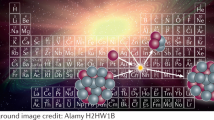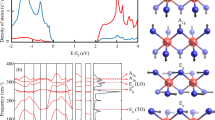Abstract
DURING the last few years it has been established, on the basis of spectroscopic and other evidence, that certain metals, for example, the alkali metals and mercury, are capable of forming di-or poly-atomic molecules in the vapour state. It is also known that the vapours of certain pairs of metals (for example, sodium-potassium, rubidium-cæsium, and their analogues, also magnesium + alkali, and mercury + alkali) contain molecules of volatile intermetallic compounds. Both types of molecule are most conveniently studied by their absorption spectra, and most of them have been discovered in this way.
This is a preview of subscription content, access via your institution
Access options
Subscribe to this journal
Receive 51 print issues and online access
$199.00 per year
only $3.90 per issue
Buy this article
- Purchase on Springer Link
- Instant access to full article PDF
Prices may be subject to local taxes which are calculated during checkout
Similar content being viewed by others
Author information
Authors and Affiliations
Rights and permissions
About this article
Cite this article
WALTER, J., BARRATT, S. Spectra of Intermetallic Compounds. Nature 122, 684–685 (1928). https://doi.org/10.1038/122684b0
Issue Date:
DOI: https://doi.org/10.1038/122684b0
This article is cited by
Comments
By submitting a comment you agree to abide by our Terms and Community Guidelines. If you find something abusive or that does not comply with our terms or guidelines please flag it as inappropriate.



